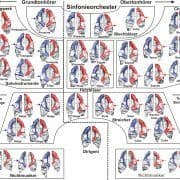Can you hear the melody? – Take the Hearing Test
In just 3:20 minutes, this listening test opens your ears to a new dimension of hearing that only around 5% of musicians are aware of: overtone listening. This ability is essential for learning overtone singing. And it is a prerequisite for the practical realisation of vocal and choral phonetics.
New Videos
In 2004, a research group led by Dr Peter Schneider at Heidelberg University Hospital discovered that people perceive sounds differently depending on which hemisphere of the brain is responsible for processing the sound. They developed the Heidelberg Hearing Test to find out whether someone tends to perceive fundamental tones or overtones in a sound. →You can take the Heidelberg test here
My hearing test is different. It tests whether someone is more likely to recognise vowels or overtones in a sound. In the second part, it teaches you to shift the threshold between vowel and overtone perception in favour of the overtones.
Saus’ Hearing Test
Relax and listen to the first sound example. I am singing a series of meaningless syllables on a single note. If you recognise a well-known classical melody in it, then congratulations, you have a pronounced overtone hearing and are one of the 5% of people who have this perception spontaneously.
Sound example 1
If you can’t hear the melody, don’t worry. At the end of the listening test you will hear the overtones.
In the next sound examples, I remove more and more sound information from the voice, which the brain interprets as part of speech. Next, I sing the syllables by changing only the 2nd vowel formant. I keep the first one unmoved in a low register. The syllables then only contain Ü sounds, the melody now becomes clearer for some.
Sound example 2
If the melody is now clear, congratulations. At this point 20-30% hear the melody. But maybe you only sense the melody and don’t know whether you are imagining it. Trust your imagination. After all, your hearing picks up the melody, but a filter in your consciousness tells you that the information is not important. Speech recognition is much more important.
I want to reveal the melody at this point: It is “Ode to Joy” from the 9th Symphony by Ludwig van Beethoven. In the next sound example, I whistle it tonelessly. This will help your brain learn what to listen for. Afterwards, listen to sound example 2 again.
Sound sample 3
Is it easier now? If not, listen to the next example.
In sound example 4, I leave out the consonants. Now Broca’s centre, the brain region for speech recognition, has nothing more to do and passes the auditory attention on to other regions.
Sound example 4
Now about 60-80% are on board. If you can’t hear the melody here, you are probably categorised as a fundamental listener in the Heidelberg hearing test. This has nothing to do with musicality. You are in the company of some of the best flutists, drummers and pianists.
In the next example, I completely defamiliarise the sound. I lower the third formant by 2 octaves with a special tongue position until it reaches the same frequency as the second. This creates a double resonance that does not occur in the German language.
Sound example 5
The technique is called overtone singing. The ear now lacks information from the usual vocal sound and individual partials become so loud due to the double resonance that the brain separates the sounds and informs your consciousness that these are two separate tones.
You will probably now hear a flute-like melody and the voice. Overtone singing is an acoustic illusion. In fact, you are hearing more than 70 partials. Physical reality and perception rarely coincide.
In the last sound example, I go all the way back to the beginning. Try to keep your focus on the melody the whole time. Listen to sound example 6 more often, it trains your overtone hearing and makes you more aware of the sound details.
Sound sample 6
Our reality is created within ourselves. And it can be changed.








I must say, this page, test, and the samples solved my long-lasting confusion. When hearing chords or harmonics, I always hear some high pitch notes that doesn’t exist in that chord or harmony, like when hearing a major 3rd(C E), I could always hear a octave E instead the actually E. When it comes to other chords, I could always hear other notes in it. For example, I sometimes recognize a triad as a 7th chord or 9th chord, because I could hear a much higher note ringing above the chord . Especially when it comes to low pitch chords, there are so many other notes in my ear that confused me. I guess its because lower pitch has longer overtone series. Turns out I’m a overtone listener. That solves so many problems! I wonder if you have any suggestions for music productions(mixing e.g), ear training, etc. thank you
So it’s six samples of nonsense singing? What’s the point of this?
Hello God,
the point is, that everybody starts hearing the melody of “Ode to Yoy” at some point of the experiment, although nowhere a tone is changed.
Your comment suggests that you don’t hear the melody. The case has not yet occurred. You’d be the first of thousands by now not to notice the melody.
LOL, this just made me find with little bit of SoundHound help that Blondie “call me” is probably plagiarism! Thank you for this excellent article.
Fantastic! What an ear opener
Ich bin hier gelandet, weil ich nach Tone Deafness Tests gegoogelt hatte, da ich starke Probleme habe zu erkennen ob ich richtig singe. Auf Instrumenten erkenne ich recht schnell, wenn ein Ton falsch ist, bei (meinem) Gesang teilweise überhaupt nicht, auch wenn er stellenweise ein paar Töne daneben liegt. Ich bin laut dem anderen Test ein Obertonhörer und habe direkt im 1. Beispiel Ode to joy erkannt. Das gibt mir ein bisschen Hoffnung, dass ich nun vielleicht auf andere Weise “hören lernen” kann.
Hallo Tobi,
ich habe öfter die Erfahrung gemacht, dass Kinder, die Töne nicht vom Klavier abnehmen können, sogenannte “Brummer”, es dann sofort können, wenn man ihnen die Töne in ihrem eigenen Klang und in ihrer Tonhöhe vorsingt, anstatt sie vom Klavier zu spielen. Wenn man dann zunächst langsam den Tonumfang vergrößert, lernen sie recht schnell, präzise die Töne zu treffen.
Bonjour, hello,
First sample .. wow got the rhythm of this classical piece. To me, the rhythm was more , a bit more obvious. As to the Exemple 3 , to me, the whistle is not toneless. I can’t explain it but I sense, hear the melody ! Ha bizarre , intéressant ! Merci à vous.
Hello Denise,
thank you for your comment. It is unlikely that you recognized the rhythm, because I changed it in the first examples and sang all notes equally long. It is more likely that you heard the melody as a sequence of notes, but the overtones had not yet reached your full consciousness when you first recognized them. Our perception is indeed fascinating.
merci pour votre commentaire. Il est peu probable que vous ayez reconnu le rythme, car je l’ai changé dans les premiers exemples et j’ai chanté toutes les notes de la même longueur. Il est plus probable que vous ayez entendu la mélodie comme une séquence de notes, mais que les harmoniques n’avaient pas encore atteint votre pleine conscience lorsque vous les avez reconnues pour la première fois. Notre perception est en effet fascinante.
It is easier when you ever heard overtone singing so you know on which you have to concentrate. That’s why I probably heard the welknown melody the second time I played the first example, also by the rhythm. (I’m playing music ). Interesting article!!
Nachdem ich das Beispiel tonlos pfeifen gehört habe, habe ich die Melodie auch in den anderen Beispielen gehört, und nicht nur anhand der Rhythmik erkannt. Obwohl mich der Heidelberger test als extremer obertonhörer ausgewiesen hat. Es könnte aber auch daran liegen das ich den test nur stumpf auf dem Handy gemacht habe
Wusste es nach 5 Sekunden bei Nr. 1. Da ich überhaupt kein musikalisches Gehör habe, würde mich mal interessieren, ob es noch ein anderes Beispiel gibt.
Wie kommt es, dass ich beim 3. Beispiel erstmal gar nichts höre, obwohl ich die Melodie bei 2 schon erkannt hatte? Erst nach Hören aller Beispiele habe ich bei 3 die Melodie ganz ganz leise auch gehört
Sehr, sehr interessant! Ich habe zunächst diesen Test gemacht und die Meldodie erst bei Beispiel vier gehört. Im Rückwärtsgang habe ich es dann aber bis zum ersten Beispiel gehört und seither bleibt es so – tatsächlich wie bei einem Vexierbild! Danach habe ich den Test von Peter Schneider gemacht und es kam heraus, dass ich ein “leichter Grundtonhörer” bin – ich habe aber beim nochmaligen Testen festgestellt, dass ich das Gehör irgendwie “umstellen” kann und tatsächlich statt einer Aufwärts- auch eine Abwärtsbewegung (und umgekehrt) hören kann – ich habe das Gefühl, dass man das richtig trainieren kann, stimmt das? Interessanterweise spiele ich Cello und wäre damit eigentlich ein Obertonhörer – es würde mich interessieren, ob das Ergebnis anders wäre, wenn ich es nicht an meinem kleinen Laptop, sondern mit guter Akustik machen würde!
Ein phantastisches Beispiel. Ich bin gerade reichlich happy, da ich – trotz Schwerhörigkeit – die Melodie bereits bei Beispiel 2 erkannt habe. Wirklich wunderschön.
Super erklärt und nachvollziehbar vorgetragen. Aber was nutzt mir als Nicht-Musiker das Vermögen, Obertöne zu hören? Steigert das den Musikgenuss und wenn ja: Ist es erlernbar/trainierbar?
Keine Ahnung ob das sein kann – aber ich (ggf. kommt es mir ja nur so vor…) höre die Melodie mit dem linken Ohr viel deutlicher heraus als mit dem rechten. Mit dem rechten tue ich mich bei 2 noch schwer, mit dem linken höre ich 1 bereits viel deutlicher. Kann das sein? Ist dies damit gleichbedeutend, dass ich rechts generell schlechter höre oder spielen da ggf. sogar die Hirnhälften eine Rolle?
Hochinteressant. Ich habe die Melodie erst bei Beispiel 4 gehört, im Rückwärtsgang dann aber gut bis Beispiel 2 und bei Beispiel 1 als Ahnung. Die Wahrnehmung verschiebt sich deutlich. Ich habe vor ca. 20 Jahren eine Zeit lang E-Gitarre gespielt und höre seit Kindertagen viel und auch intensiv Musik allerlei Stilrichtungen.
Schöne Idee und tolle Umsetzung!! Auch wenn ich persönlich seeeehr wenig mit Musik zu tun habe, war es ein spannender Test! :)
Vielen Dank für die Mühe!
Sehr interessant, ich war mir sofort sicher “Freude schöner… “erkannt zu haben , aber beim ersten Beispiel wegen des Rhythmus . Beim zweiten Beispiel war ich mir dann sicher. ( ich singe übrigens viel ( mittlerweile wieder Alt) undspiele Klavier und Orgel.
Servus Wolfgang.
Wenn man schon Erfahrung mit Obertönen hat, dann hört man es gleich beim erstenmal, oder?
Lieber Gruss
Barbara
Empfand ich ebenfalls wie der zu lesende Kommentar .Ein neues Wahrnehmungstürchen öffnete sich mehr und mehr .☆☆☆☆ Das ist es .
Toll gemacht!
Es ist einfach faszinierend, wie Du den Ton immer klarer und klarer werden lässt…
Ich wäre froh, wenn ich solch eine (Ober-)Tonfolge so klar hervorbringen könnte!
ach, und nachdem ich den Heidelberger Test erstmal kapiert hatte bekam ich mitgeteilt daß ich einabsoluter Obertonhörer sei.
Vielen Dank!
Es war wie wenn ein neues Wahrnehmungstürchen immer mehr sich geöffnet hätte
Eine spannende Untersuchung über die Wirkung unserer Erwartungen (Glaubenssysteme) auf die akustische Wahrnehmung.
https://youtu.be/93vqcBLWK-8